I read it in the stars - The History of the Zodiac
I READ IT IN THE STARS
- THE HISTORY OF THE ZODIAC -

A)
Babylonia


|
In the MUL.APIN |
Signification |
In the western zodiac |
|
LU.HUNG.GA |
Field Worker |
Aries |
|
GU.AN.NA |
Heavenly Bull,
The Bull of Heaven |
Taurus |
|
MASH.TA.BA |
Twins, The Great
Twins |
Gemini |
|
AL.LUL |
Pincers,
Crayfish |
Cancer |
|
UR.GU.LA |
Lion, The Lion |
Leo |
|
AB.SIN |
Daughter of Sin,
The Seed-Furrow |
Virgo |
|
ZI.BA.AN.NA or
GISH.ERIN |
Heavenly Fate,
The Scales |
Libra |
|
GIR.TAB |
That Which Claws
and Cuts, The Scorpion |
Scorpio |
|
PA.BIL.SAG |
Defender, The
Overseer |
Sagittarius |
|
SUHUR.MASH |
Goat-Fish, The
Goat-Fish |
Capricorn |
|
GU.LA |
Lord of Waters,
The Great One |
Aquarius |
|
SIM.MAH |
Fishes, The
Tails, Swallow Tail |
Pisces |
B)
Egypt
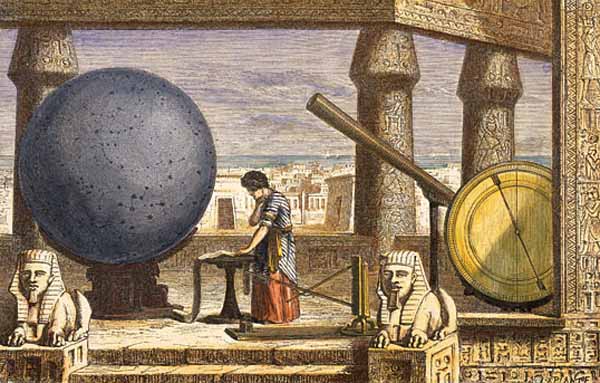
The second one is deeply influenced by the Greek and
Babylonian astronomy. The latter method of assigning a date is very similar to
Western Astrology.
In 525 BCE Egypt was conquered by the Persians so that’s
where the Mesopotamian influence comes from. A solid evidence is the Dendera
Zodiac. The Dendera zodiac is an Egyptian bas-relief from the
ceiling of a chapel dedicated to Osiris in the Hathor temple at Dendera. It
contains images of Taurus (the bull) and Libra (the scales).
After the occupation by Alexander the Great in 332
BCE, Egypt came under Greek rule and influence. This is when the Babylonian
astrology was mixed with the Egyptian Decanic astrology and created the
Horoscopic astrology.
Very important to the development of the Horoscopic
astrology was Ptolemy, a astrologer and astronomer who lived in Alexandria in
Egypt. Ptolemy's work the Tetrabiblos laid the basis of the Western
astrological tradition.

|
Egyptian zodiac
|
Date (based on
the Decans)
|
Date (based on
the Greek influence)
|
Personality
|
|
Osiris
|
1st – 10th Mar
27th Nov. – 18th
Dec.
|
March 27 – April
25
|
Intelligent and trustworthy.
|
|
Amun-Ra
|
8th – 21st Jan
1st – 11th Feb
|
April 26 – May 25
|
Understanding, strong, determined and tactful.
|
|
Seth
|
28th May – 18th Jun
28th Sept – 2nd Oct
|
n/a
|
Freedom loving and adventurous.
|
|
Bastet
|
14th- 28th Jul,
23rd – 27th Sept
3rd – 17th Oct
|
n/a
|
Calm, pensive and reserved.
|
|
Anubis
|
9th – 27th May
29th Jun – 13th Jul
|
July 25 – August 28
|
Great imagination, joyful and curious.
|
|
Thoth
|
1st – 19th April
8th – 17th November
|
August 29 – September 27
|
Wise, creative and smart
|
|
Geb
|
12th – 29th Feb
20th – 31st Aug
|
n/a
|
Truthful, faithful and open.
|
|
Mut
|
22nd – 31st Jan
8th – 22nd Sept
|
n/a
|
Determined, goal orientated and calm.
|
|
Hapi
(The Nile)
|
1st – 7th Jan
19th – 28th Jun
1st – 7th Sept
18th – 26th Nov
|
n/a
|
loving, kind and
understanding.
|
|
Horus
|
20th Apr – 8th May
12th – 19th Aug
|
September 28 – October 27
|
Determined, real and ambitious.
|
|
Sekhmet
|
29th Jul – 11th Aug
30th Oct – 7th Nov
|
November 27 – December 26
|
Chatty, fun and positive.
|
|
Isis
|
11th – 31st March,
18th – 29th October
19th – 31st December
|
February 25 – March 26
|
Funny, creative and laidback.
|
|
Wadjet
|
n/a
|
Oct 28 – Nov 26
|
Cautious, very loyal to your beliefs and giving,
handy
|
|
Shu
|
n/a
|
Jan 26 – Feb 24
|
very creative and talented, but you don't always
trust yourself
|
|
Phoenix
|
n/a
|
Jun 25 – Jul 24
|
you take advantage of all opportunities, optimistic,
caring
|
|
Sphinx
|
n/a
|
Dec 27 – Jan 25
|
very flexible, very disciplined, discerning, serious,
sophisticated.
|
|
Hathor
|
n/a
|
May 26 – Jun 24
|
emotional and quite the romantic, jealous and angry,
extrovert
|
C)
The
Celts

|
The Celtic Zodiac |
Date |
Personality |
|
Rowan |
22 Jan – Feb 18 |
Idealistic visionaries with strong humanitarian and
spiritual concerns |
|
Ash |
19 Feb – 17 Mar |
Dual nature: having an artistic and vulnerable side
and a logical and realistic side |
|
Alder |
18 Mar – 14 Apr |
Adventurous, brave, competitive and funny |
|
Willow |
15 Apr – 12 May |
Intelligent, stubborn, secretive, familyists |
|
Hawthorn |
13 May – 9 Jun |
Charismatic, creative, sociable, clever |
|
Oak |
10 Jun – 7 Jul |
Charismatic, determined, self-motivated, optimists |
|
Holly |
8 Jul – 4 Aug |
Practical, strong, perfectionists, some-what
introvertists |
|
Hazel |
5 Aug – 1 Sept |
Clever, detailed-oriented, have a low self-worth,
nervous |
|
Vine |
2 Sept – 29 Sept |
Refined, perceptive, kind, mood swingers |
|
Ivy |
30 Sept – 27 Oct |
Exuberant, unique, friendly, funny, optimistic,
highly energetic |
|
Reed |
28 Oct – 24 Nov |
Jealous, proud, great friends and leaders |
|
Elder |
25 Nov – 23 Dec |
Highly intelligent, energetic, waste their young years,
they think they are always right |
|
Birch |
24 Dec – 21 Jan |
Goal oriented, need to succeed, workaholics, always
have a routine |
D)
Mayan
Astrology
Like the Western Astrology, the Mayan Astrology analyzes the sky to predict the life of an individual, but also looks at the time. Time was a really big deal for the Mayans. They interpret the sky by looking at what happened on Earth at the time of the event.
At the Mayans, days are grouped to form something like a calendar. The most important group comprises 260 days and it forms the Mayan Calendar, also called tzolkin. The tzolkin is the base of the Mayan Astrology.
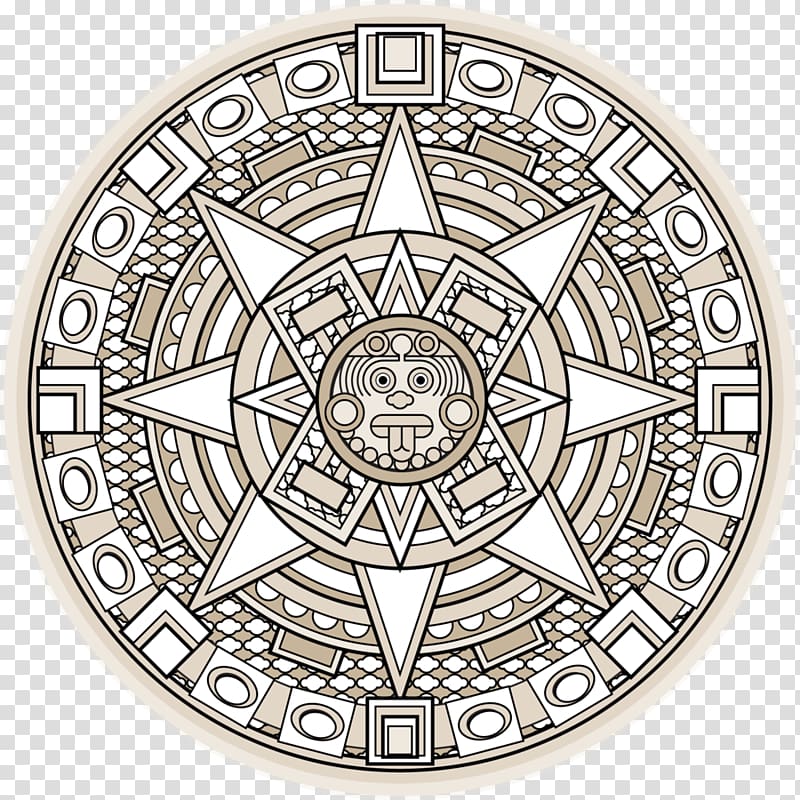
The tzolkin contains:
1.
Day-Signs – These are a part of the Mayan zodiac signs. The
calendar divides the year into groups of 20 days, each having its sign, which
reveals the personality and life purpose.
2. The
Trecena - This is
another kind of Mayan zodiac sign. They are like the moon signs from Western
Astrology. The tzolkin is divided into 20 groups (13 days each) that tell us
about the deeper qualities of the personality.
3.
The
Lords of the Night
– The tzolkin is further divided into groups of 9 days. These groups correspond
to a particular God of the Underworld and symbolize the part of ourselves we
keep hidden.
4.
The
Year – The tzolkin
also groups years into cycles of 52. Each year in a cycle has its name and its
quality. People born in a specific year have similar qualities as other people
born in the same year.
5.
The
Cycle of Venus
– The tzolkin also looks at the 4 phases of Venus. The phase you're born into
tells you your social values and your role in society.
The Mayans have a small connection to the Western
Astrology. Whereas the Western zodiac attributes an element to each sign, The
Mayan attributes a direction (North, South, East, or West) to every day-sign.
|
Mayan zodiac sign |
Meaning |
Direction |
Personality |
|
B’atz |
Monkey |
East |
Great planner, easily able to see the bigger picture,
artsy, outdoorsy |
|
E |
Path |
West |
Diplomatic, a natural leader, a gifted storyteller |
|
Aj |
Authority |
North |
Bookworm, intelligent, cheerful, spiritual, great secrets
keeper |
|
I’x |
Jaguar |
South |
strong, passionate, courageous and full of energy,
dreamy, natural affinity for animals |
|
Tz’ikin |
Bird of Power |
East |
very lucky with money, outdoorsy, generous, friendly,
a great strategist, sociable |
|
Ajmaq |
Curiosity |
West |
Healthy, analytical, quiet and great secret keeper,
mysterious, nice |
|
No’j |
Knowledge |
North |
noble, wise and intelligent, too trusty, great in
relationships |
|
Tijax |
Double-edged knife, obsidian |
South |
Sickly, great with people, highly talented, and
extremely intelligent, a nice balance between intuition and rationality |
|
Kawoq |
Family |
East |
highly motivated and caring, a calming influence on
those around you, intelligent |
|
Ajpu |
Sun |
West |
Confident, optimistic, energetic, careless, picky, in
love with the idea of love |
|
Imox |
The Left Side |
North |
Homebody, generous, open-minded, stubborn, dramatic,
romantic |
|
Iq’ |
Wind |
South |
Devoted to your passions, impulsive, changeable,
obsessive, intelligent |
|
Aq’ab’al |
Dawn |
East |
Happy, spiritual, determined, generous, respected,
slow ager |
|
K’at |
Net |
West |
Honest, genuine in what you do, curious,
materialistic, emotional, energetic |
|
Kan |
Snake |
North |
Natural leader, introvert, very intelligent and a
natural athlete, bookworm |
|
Kame |
Death |
South |
the ability to predict the future and to solve the
unknown, intuitive, intelligent, spiritual, charismatic, adventurous |
|
Kej |
Deer |
East |
great adviser and leader, analytical, gentle,
romantic, determined |
|
Q’anil |
Seed |
West |
very creative and intuitive, adventurous, outdoorsy,
bookworm, protective |
|
Toj |
Fire |
North |
very lucky and receive many gifts, charismatic,
warm, full of energy, jealous |
|
Tz’i’ |
Law, Dog |
South |
Faithful, kind, lucky in love, balanced, able to get
rid of the negative energy |
E)
Greece
Greek zodiac
is the most famous zodiac in the world. Their zodiac signs and interpretations
had passed through time and, in the end, became the basis of the Western
Zodiac.
Greece didn’t
know much about the interpretation of the stars. They came into contact with it
after being conquered by Alexander the Great. At the moment of the Greek
conquest, Alexander the Great already ruled over a vast empire that occupied 3
continents: Europe, Asia, and Africa. So, Alexander the Great had an important
role in the widespread of astrology as his work meant the Greeks now became
accustomed to the Babylonian and Egyptian zodiac. After the vast empire
dissolved, Greece entered the Hellenic period.
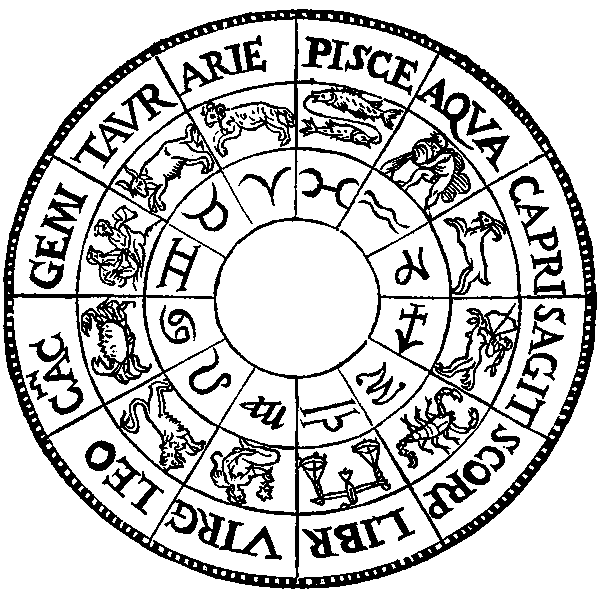
In the
Hellenic period, the zodiac became a subject of interest, especially, after
Berossus, a priest from Babylon, arrived in Greece to teach them about
astrology. That’s how Greek astrology was born: a mixed version of the two most
known astrology. They took the names and dates from Babylon (as it was the
prime source) and the link to the gods from Egyptians. But the Greek zodiac
surpassed the Egyptian zodiac and became dominant in the African region. That’s
why there were two schools of astrology in Ancient Egypt.
The Greek
zodiac gives two interpretations of the stars: the horoscope, to establish
precise details about the past, present and future, and the theurgic
interpretation, meaning god-work, and emphasize the soul's ascent to the stars.
|
The Zodiac Sign |
The Myth |
|
Aries |
the myth of the
Golden Ram |
|
Taurus |
the legend of
Theseus and the Minotaur |
|
Gemini |
the story of the
twin brothers Castor and Pollux |
|
Cancer |
the second labor
of the mighty hero Hercules (the killing of Lerna Hydra) |
|
Leo |
Hercules' very
first labor, the capture of the Nemean Lion. |
|
Virgo |
he story of
Demeter and her daughter Persephone |
|
Libra |
the symbol of
Dike, a minor goddess of the Underworld. |
|
Scorpio |
the story of the
mighty hunter Orion |
|
Sagittarius |
The might of Cheiron,
the king of the centaurs |
|
Capricorn |
the birth of
Zeus, the father of all gods. |
|
Aquarius |
The myth of Ganymede,
the son of king Tros |
|
Pisces |
The story of
Aphrodite |
F) Hebrew
The astrology
with its zodiac signs has always been a complicated subject for the Jews. They
never considered it a proper science and never taught it, though there are many
references to it in the Talmud (the central text of Rabbinic Judaism and the
primary source of Jewish religious law and Jewish theology). The rabbis have
different views on it: some reject its validity, while others accept its
validity but prohibit it. Still, some thought its practice to be meaningful and
permitted.

Zodiac from the 6th century in a sinagoge
During the First Temple period, astrology was only mentioned regarding the Babylonian practices. During the Second Temple period, there is even less information about it. The Sibylline oracles praise the Jewish nation because it "does not meditate on the prophecies of the fortune-tellers, magicians, and conjurers, nor practice Astrology, nor seek the oracles of the Chaldeans (aka the Babylonians) in the stars". During the Talmud period, the first signs of Hebrew astrology appeared, in the form of planets dictating one’s character and medical practices (like not bleeding a patient on certain days). In the Middle Ages, astrology was practiced by some, both as a professional-art and as a science. Jews were sometimes thought heirs and successors of the Babylonians. For this reason, Jews sometimes were regarded by the Western world as masters of astrology.
|
Month |
Hebrew name |
Latin Name |
|
Nissan |
Taleh |
Aries |
|
Iyar |
Shar |
Taurus |
|
Sivan |
Teomim |
Gemini |
|
Tammuz |
Sartan |
Cancer |
|
Av |
Aryeh |
Leo |
|
Elul |
Betulah |
Virgo |
|
Tishrei |
Moznayim |
Libra |
|
Cheshvan |
Akrav |
Scorpio |
|
Kislev |
Keshet |
Sagittarius |
|
Tevet |
Gedi |
Capricorn |
|
Shevat |
Dli |
Aquarius |
|
Adar |
Dagim |
Pisces |
G) India
The
Indians refer to their astrology as Jyotishya, which means light, heavenly
body. More recently, the Hindu astrology is also called Vedic Astrology. Vedic
astrology is a recent term, having been used since the 1970s. It was popularized
by publications on yoga. Vedanga Jyotishya is one of the earliest texts about
astronomy within the Vedas. The mythologies Ramayana and Mahabharata contain
multiple references about Rashi (zodiac sign) based astrology.
Dating
back to about 5000 – 7000 years ago, Vedic Astrology is the oldest form of
Astrology known to us. The Vedic Astrology uses the Moon Sign as the basis of
all predictions. It also includes several systems of interpretation and prediction
with elements not found in Hellenistic astrology, such as its system of lunar
mansions, called Nakṣatra.
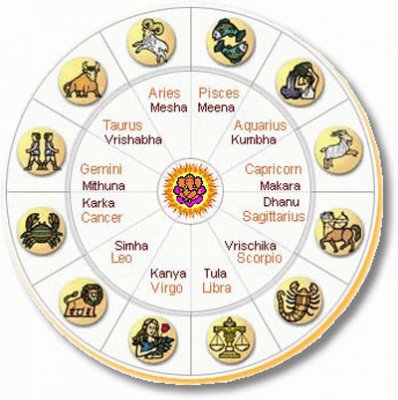
But
Hellenistic astrology had its influences on Hindu astrology as well. From it
comes the twelve zodiacal signs beginning with Aries and the ascendant. The
Yavanajātaka (the early centuries CE) is the first evidence of the transmission
of Greek astrology to India. It is considered the first Indian astrological
treatise in the Sanskrit language. However, the main Hindu astrological texts
remain the Bṛhat Parāśara Horāśāstra (7th – 8th century),
and Sārāvalī (800 AD) by Kalyāṇavarma.
|
Indian
name |
Latin name |
|
Meșa |
Aries |
|
Vrșabha |
Taurus |
|
Mithuna |
Gemini |
|
Karka |
Cancer |
|
Simha |
Leo |
|
Kanya |
Virgo |
|
Tula |
Libra |
|
Vrscika |
Scorpio |
|
Dhanusa |
Sagittarius |
|
Makara |
Capricorn |
|
Kumbha |
Aquarius |
|
Mina |
Pisces |
H)
China
It
is widely known that the Chinese zodiac is comprised of 12 zodiac signs,
repeated in a cycle of 12 years. Each zodiacal sign represents an animal. In
order, the 12 Chinese horoscope animals are: Rat, Ox, Tiger, Rabbit, Dragon,
Snake, Horse, Goat, Monkey, Rooster, Dog, Pig. 2020 is a year of the Rat. The Chinese
zodiac uses the principles of yin and yang, which alternate. Chinese
superstition says that in your birth sign year, you will offend the God of Age,
and will have bad luck during that year.
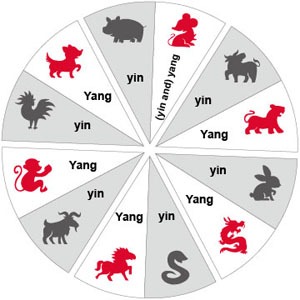
The
animal signs are also assigned to months, days of the week, and hours.
According to some, the birth hour has more to do with one’s personality than
the birth year. However, the birth year, month, day and hour all show the depths
of one’s personality.
The
legend behind the Chinese zodiac says that long before our time there was no
Chinese zodiac. In these times, The Jade Emperor proposed a competition between
the animals of the mortal land. He said that the first 12 animals to reach the
Heavenly Gates would become his guards.
The
rat woke up early and this was to his advantage. Unfortunately, he encountered
a river he could not cross, but behind him, he saw the ox. The rat quickly
climbed the ox’s ear and so they crossed the river. But when they were close to
the gate, the rate jumped from his place and so he ranked first and the ox
second. Next to court arrived tiger and rabbit, both fast and competitive. The
next one was the dragon. The emperor was so delighted with it that he said the
next rank (the 6th) would belong to his son. But the dragon’s son
didn’t come along, and, getting advantage out of the situation, the snake
pretended to be the adoptive son. The horse and goat arrived next, but they
both wanted to let the other go first. So, the emperor ranked them. The monkey,
though he jumped between trees and stones, had fallen behind and ranked nine.
Last come the rooster, the dog and the pig.
|
The Chinese Sign |
Personality |
|
Rat |
Quick-witted, resourceful, versatile, kind |
|
Ox |
Diligent, dependable, strong, determined |
|
Tiger |
Brave, confident, competitive |
|
Rabbit |
Quiet, elegant, kind, responsible |
|
Dragon |
Confident, intelligent, enthusiastic |
|
Snake |
Enigmatic, intelligent, wise |
|
Horse |
Animated, active, energetic |
|
Goat |
Calm, gentle, sympathetic |
|
Monkey |
Sharp, smart, curiosity |
|
Rooster |
Observant, hardworking, courageous, |
|
Dog |
Lovely, honest, prudent |
|
Pig |
Compassionate, generous, diligent |
I)
After
Ancientry
The
Ancient Times was the peak of glory for astrology. People back then chose to
rely on astral predictions for their luck or to blame them for their unluck.
They saw the messages was a sign of the Gods. But after the replacement of the
polytheist religions with monotheist ones, especially Christianity and Islam,
their fame began to decrease as people did not rely so much on them.
However, astrology hasn’t perished, as at the
royal courts of the medieval kings, predictors were looked upon. The most famous
one was Nostradamus, a French healer, who published a book called Les
Propheties in 1555. The book had ensured his popularity even after death. Even
writers included astrological predictions in their texts. William Shakespeare
is notorious for included an ill-fated prediction in almost all his plays, for
example, in King Lear, where solar and moon eclipses predict death.
But
during the Modern Era, the era of great scientific development, astrology’s
place in the world diminished even more. Until then, astronomy and astrology
represented the same science, and an astronomer was to one to cast predictions
and read the stars. But the scientific progress meant that every so-taught
science would go through “a filter” to decide if it was, in fact, a science.
Astronomy passed to test, while astrology didn’t and at that moment a fracture
between these subjects was made. And so, astrology was out of fashion for
centuries.
In
the 1900s, the horoscopes were invented based on the stars, and interest for
astrology was reborn. It all started in 1930 with a London newspaper. The
newspaper contained a special rubric with predictions in the honor of the birth
of Princess Margaret. Many of the predictions came out to be true in a way or
another. The most important prediction states that when the princess would be
around 7 years an event of great importance for the royal family would occur.
Just days before her 7th birthday, her uncle King Edward VIII abdicated,
leaving his throne to his brother, George VI. Princess Margaret was the little
sister of the current Queen of England, Elizabeth II. After the successful
predictions, the author got his rubric in the newspaper and he began writing
horoscopes for the citizens of England, based on their sun signs.
In
the 1960s, astrology was in fashion again, zodiac sign having a place in songs.
In 1968, Linda Goodman’s book Sun signs made the New York Times bestsellers
list, having sold 300 million copies and being translated into 15 languages.
Now, horoscopes have their place in the news and magazines, mostly for
entertainment. They sometimes have therapeutic values as they can make us more
positive, productive, and creative.
Astrology and horoscopes are intriguing for
almost all people in the world. Every ancient civilization has its astrological
system. They helped the ancient people by giving them a better understanding of
their purpose or their day-to-day life. Horoscopes are interesting and
entertaining, but no matter how fascinating they might be, we mustn’t let them
seize and dictate our life. No matter how true their saying might seem, always
remember we can always force our path.
Comentarii
Trimiteți un comentariu